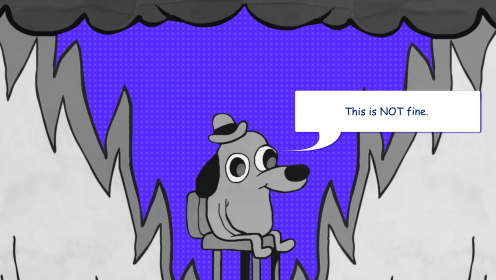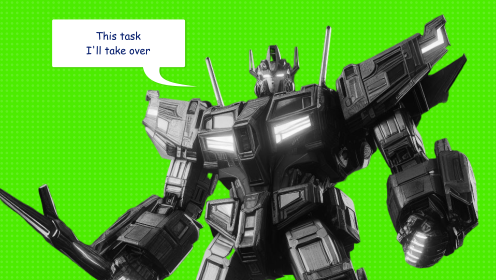💡 A content plan is a publication schedule for a blog, magazine, or brand media. It serves as a guide for the team involved in content production. The plan outlines the content release dates, publication themes, and other details.
In 2024, the direction of content continues to grow. Brand promotion, sales, conveying values and meanings of a product — such tasks cannot be accomplished without words. Words sell, engage, explain, and educate. And to avoid wandering in the dark, frantically figuring out what to write or film today, a content plan is needed.
☝🏻 A content plan provides systematic work — to avoid messing up deadlines and news opportunities, organize the team's work, save resources, and track effectiveness. It's an important tool for those in charge of the content in a company.
What Does Content Plan Include
A content plan is essentially just a list presented in the form of a schedule or table. Thus, the plan consists of items on this list. Attributes are then added to each item.
- Content Theme. The first obvious attribute. It's the subject the content is dedicated to.
- Date. Since it's a plan, each item is assigned a date. This is the deadline when the content is supposed to go public.
- Content Format and Type. This serves as a kind of labeling that helps maintain balance in the plan. (More on types of content below).
- Executors and Responsible Parties. Author, editor, PR specialist, designer, illustrator, layout artist, SMM specialist. The entire large team of the content department.
- "Anchors". Significant business-related events. These are releases, updates, launches of new products, start of courses, opening of branches, etc. — any internal news opportunities of the company that are important to the company and its loyal audience.
How to Create a Content Plan: 6 Key Steps
- 1. Gather a list of topics. Make it as extensive as possible. Eight ways to generate ideas for the plan can be found below.
- 2. Check the frequency of topics by queries (preferably with an SEO specialist or manually) and evaluate the themes accordingly. Prioritize high-frequency topics. If some themes are not popular but seem interesting, don't discard them — you can test them in a short format that will take less effort.
- 3. Consult with colleagues — product managers, bosses, PR specialists. They can help expand the pool of topics and identify the main "anchors" of the business.
- 4. Assess resources. Writing a news piece is much quicker than creating a YouTube video. To set accurate deadlines, it's necessary to evaluate how much time production will take.
- 5. Transfer the list of topics to the plan — fill out the schedule for the coming month or weeks, specifying all attributes.
❗ Allocate 20% of the space in the plan for sudden changes, missed deadlines, and significant news. A content plan is meant to organize work — not to be rigidly adhered to. Don't be afraid to make changes if the context demands it.
Types of Content for the Plan
This section will help you navigate and come up with something new. Even just by going through the list of content types, you can find new ideas — what and how to write, in what tone, length, and so on. This is helpful when you're out of ideas.
👌🏻 Label content in the plan — indicate which type each belongs to. This is a way to assess the content richness of resources and maintain balance.
I would identify two approaches to defining content types—by format and by the meaning it conveys.
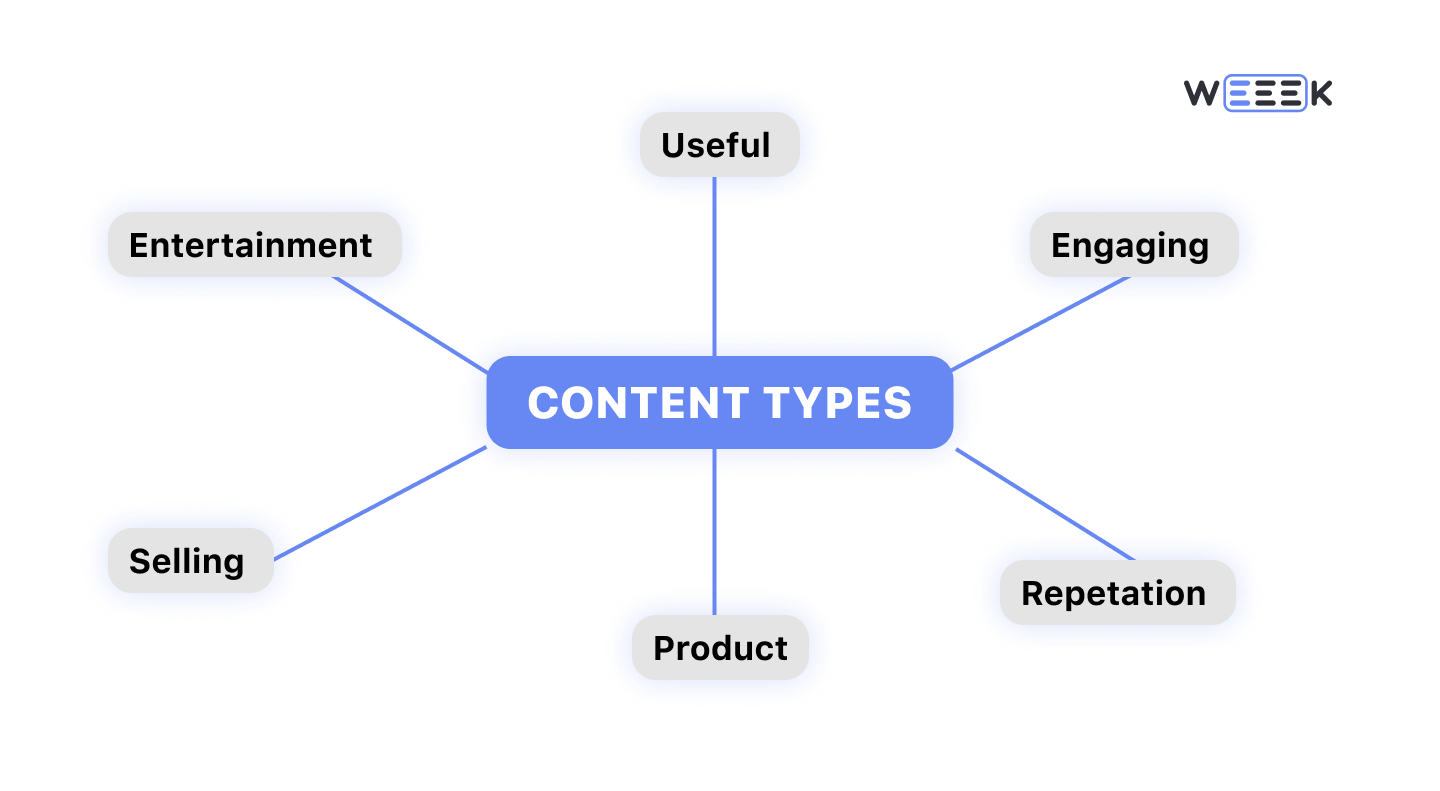
Content Formats
- Text, post, cards, letter, video, podcast, quiz, and so on. This is straightforward. And I won't delve into how text can be long or short, news, compilation, long-read, checklist, interview—otherwise, we'd never finish.
- Resize is when you repackage, for example, text into cards or a quiz. You transform one format into another.
- Reuse is when you take old text (or video, or post) and turn it into something new. For example, a text into a script for a podcast or a YouTube video. Or into a newsletter. Or you take an old text and add new information to it, extract interesting details from it, and focus on them in a new text. The same content, just viewed from a different angle.
Next, we fill these content formats with meaning—what role does the chosen content unit play. Let's go into more detail here.
Useful Content
Expert articles, guides, explanatory texts, educational videos, a set of cards with explanations, etc. Anything that can be useful to the reader — enlighten, educate, answer questions, help solve a specific problem.
Engaging Content
This type of content helps readers feel involved in what's happening and share their opinions. These are quizzes, contests, surveys, games. Here, you catch three birds with one content piece: retain visitors on the resource longer, entertain readers, and learn more about the audience.
Entertaining Content
These are jokes, memes, comics, reels — such lighthearted fun entertains without teaching or advising. This content helps to connect with the reader. And if you subtly pack the utility and values of the product into it — that's top-notch skill.
Reputational Content
Content that boosts the company's reputation. These are case studies, success stories, collaborations, integrations, webinars, presentations. I'll add expert articles from company representatives here. All this increases brand awareness and trust in the company.
Sales Content
Promotions, advertisements, new products, special offers, contests. But, in general, any type of content should and can sell.
Product Content
My favorite type of content! With its help, we talk about the company's product — guides on "How to use," reviews, life hacks. It works great for engagement, utility, reputation, sales. And all this with care for the reader!
8 Sources of Ideas for the Content Plan
❗️The basis for selecting themes for the content plan is the rule — not to choose a topic just because it seems good, or because some news opportunity has come up, or because the boss wants it.
The choice of topic should be based on specifics that will ensure the content's success — audience pain points and real problems. Every idea needs to be verified and checked for demand among people.
Okay, but where to get ideas? Get ready for the annoying advice — from everywhere. But it's true. Knowledge, a life event, a book, a movie. Any occasion can be tied to your brand or product.
- Ask your audience. A long but good way is to conduct interviews. Something like customer development or in-depth interviews. Or conduct a survey (which is also engaging content) and ask what people want to learn about. Or start a regular column "Ask ... (your brand's name)" and ask readers to write to you about their problems.
- Interact with experts or clients. They are a source of real knowledge about the topic and audience requests. They see the big picture, convey the audience's needs, and also have a good understanding of the topic.
- Talk to colleagues. Owners, product managers, PR team can help generate ideas — they also understand the audience's pains and are deeply immersed in the topic. They can advise on internal news opportunities.
- Read books, watch movies. Non-fiction, popular science literature, documentaries, or semi-documentaries are sources of theory, practice, inspiration.
- Follow competitors. And steal like an artist. Repurpose themes, cool solutions, and unusual approaches for your situation.
- Gather low-hanging fruit. Life events are free sources of ideas! Any life situation can become the basis for content.
- Use the calendar of news hooks. Of course, some are quite cringy — but now and then, you'll find a suitable occasion for a post, news, or newsletter among them.
- Review old content — and think about how to repackage it. It's the minimum effort for a good result. And that's what all media do.
AI for the Content Plan
To the collection of ways to find ideas, let's separately add the help of artificial intelligence.
ChatGPT and OpenAI from Notion are at least two cool tools for generating ideas, short texts, and posts, SEO text structure, keyword selection, and more.
Here, for example, is the response to our request to draft 10 themes for a blog:
And here, for instance, we turned to OpenAI for an SEO structure for a text about FOMO syndrome:
Of course, it's necessary to learn how to make requests correctly — and AI will indeed be beneficial in content creation.
3 Best Programs for Creating a Content Plan
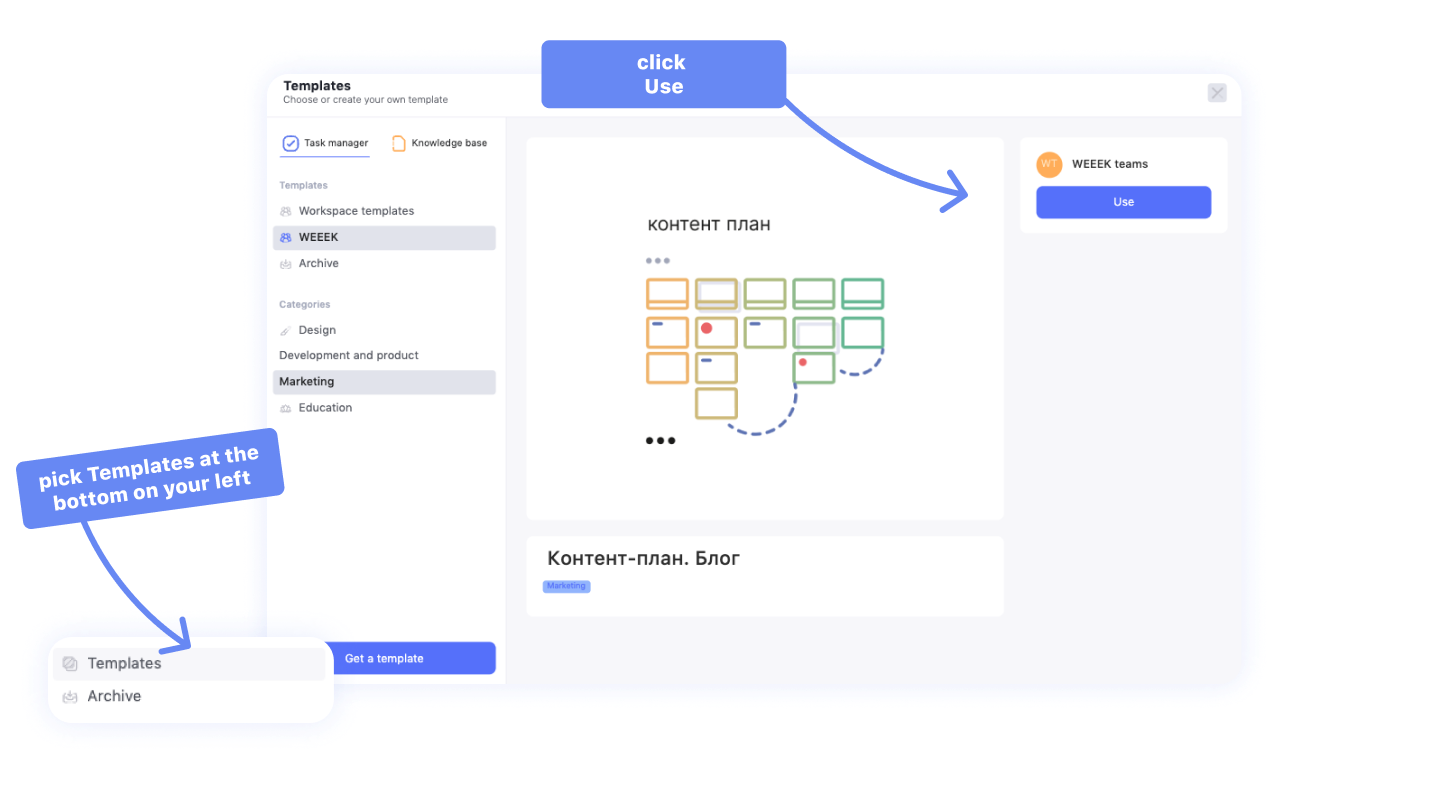
I'm not sure how convenient it is to maintain a content plan on a large sheet of paper, but for me, only software applications were suitable. I'll describe three of them.
WEEEK for the Content Plan and a Ready-Made Template
If you want to try planning content production the way we do it at WEEEK, use our open content plan template for a blog: we've created it based on the model of our own blog publication plan.
To access the template, you need to register in WEEEK.
In your workspace, at the bottom left, you'll see a "Templates" button. There, in the "Marketing" section, lies the "Content Plan" template. Use it. A new project with the same name will be created for you. Go to the Kanban boards — and the content plan will open up before you.
Before WEEEK, I managed content plans only in Google Sheets. But once I joined the company, I immediately got hooked on WEEEK. It turned out to be very convenient to work in one place — where you can keep a plan for the month and work on individual tasks.
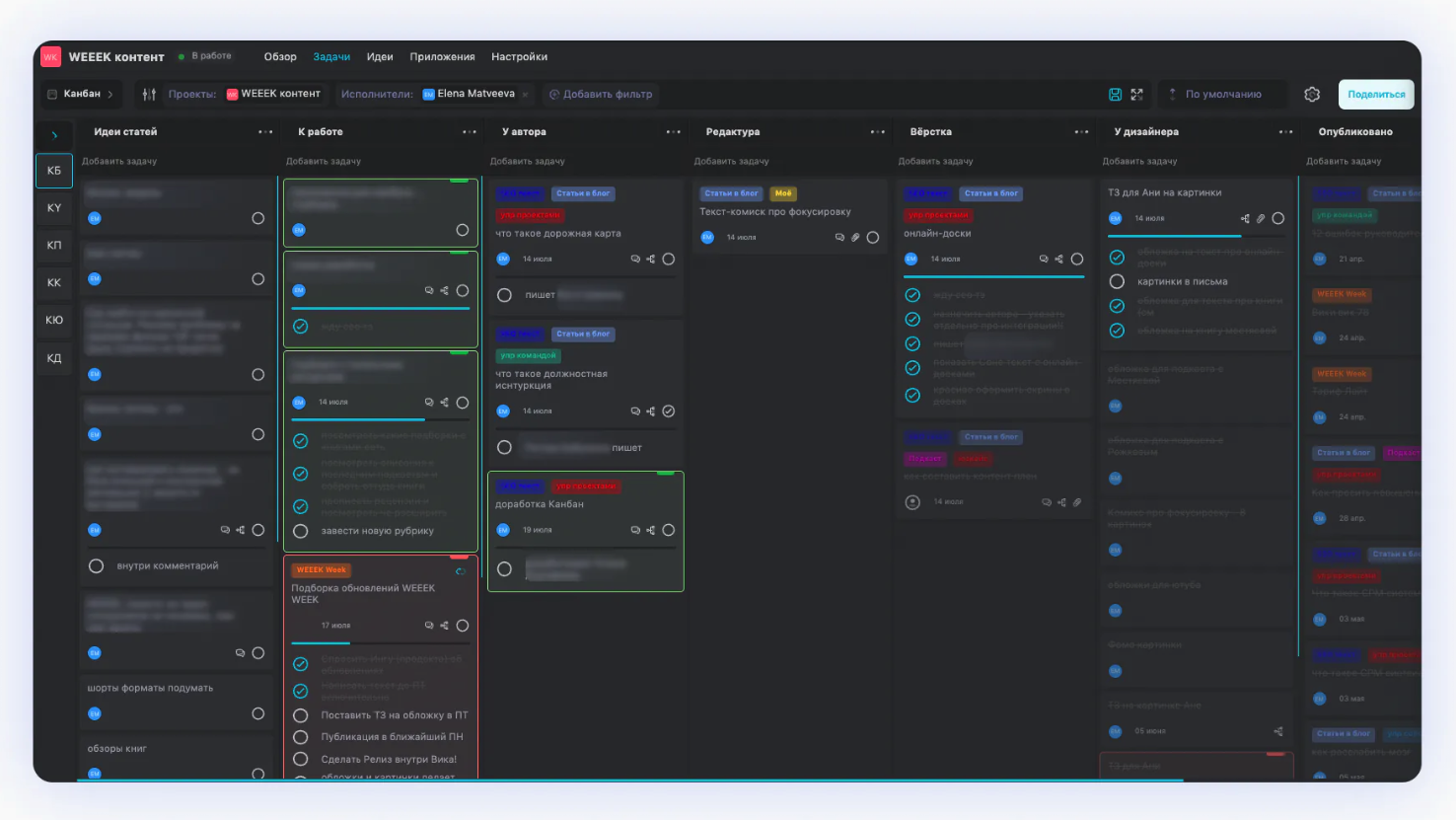
Creating a content plan in WEEEK for me starts with the Kanban board. There's a column for "Theme Ideas" — mine and from the SEO notebook. From there, together with the SEO specialist, we take themes for the next two weeks. From the selected themes, I form a plan for the month.
When a theme is moved to the "To Do" column on the board, it is tagged with labels that characterize the type of content and subtasks—assigning an author, editing, thinking about visuals, and so on.
I set the main task with the planned publication date, and for subtasks — intermediate dates, so everything is ready by the release date. And in the calendar, not the entire big task is displayed, but only one subtask.
The Kanban board helps to track work in real-time. And when I need to look at the plan for the month, I switch to calendar view mode and apply a filter by the "Blog Articles" tag.
Inside the task card, I attach links to texts from authors (and any other documents), in files — references for illustrations, sketches for the designer, and then the finished images from the designer. All necessary artifacts in one place — they're quick to access and nothing gets lost.
On the day of publication, I simply take all the artifacts from the task and lay out the text. There's no need to scroll through chats or remember the name of the text to find it in the documents. This greatly accelerated production and release. Moreover, in WEEEK, I now drop ideas for new themes — it significantly cleared my head.
Notion for Content Planning
In Notion, you can also work with Kanban boards, weekly, or monthly calendars. What I really like here are the super convenient documents and the ability to interlink parts of the plan with other data from the program. For quality and thoughtful work on content, Notion is perfectly suited.
I had the opportunity to work with Notion in a company where, besides me, a product manager and a producer also contributed to the content plan. The three of us shared a common content plan, and we borrowed, resized and reused ideas from each other.
In this sense, a shared program for working on content is a real blessing.
Notion is a cool, convenient, and fast tool that combines the advantages of a planner and a team workspace. The downside is it's expensive for teamwork.
Google Sheets
Google Sheets is a classic for content work. In a spreadsheet format, it's arguably the easiest way to view a monthly publication plan. Here, you need to give the spreadsheet the appearance of a wall calendar: divide it into cells, mark them with dates, and label them.
The plus of Google Sheets is that the content plan table will be understandable to anyone who opens it. And anyone with any technical background can create it — there's absolutely nothing complicated.
With the transition to WEEEK, I realized the disadvantages of using Google Sheets for content planning— it takes much longer. Types of content, dates, color markers — all have to be done manually. And if there's a lot of content, and it's all different, then the table either becomes huge or as colorful as a Christmas tree (and no one but the creator will be able to understand it). Plus, from Google Sheets, you have to use different programs to collect images, texts, banners.
***
A content plan is a very useful tool. Without it, stable content production would fall apart and it would hardly be possible to build a system. Nevertheless, if a content plan is necessary, can only be decided by those who deal with it in the company. For this you need to know the goals of content marketing, the volume of work, and the number of people involved.









